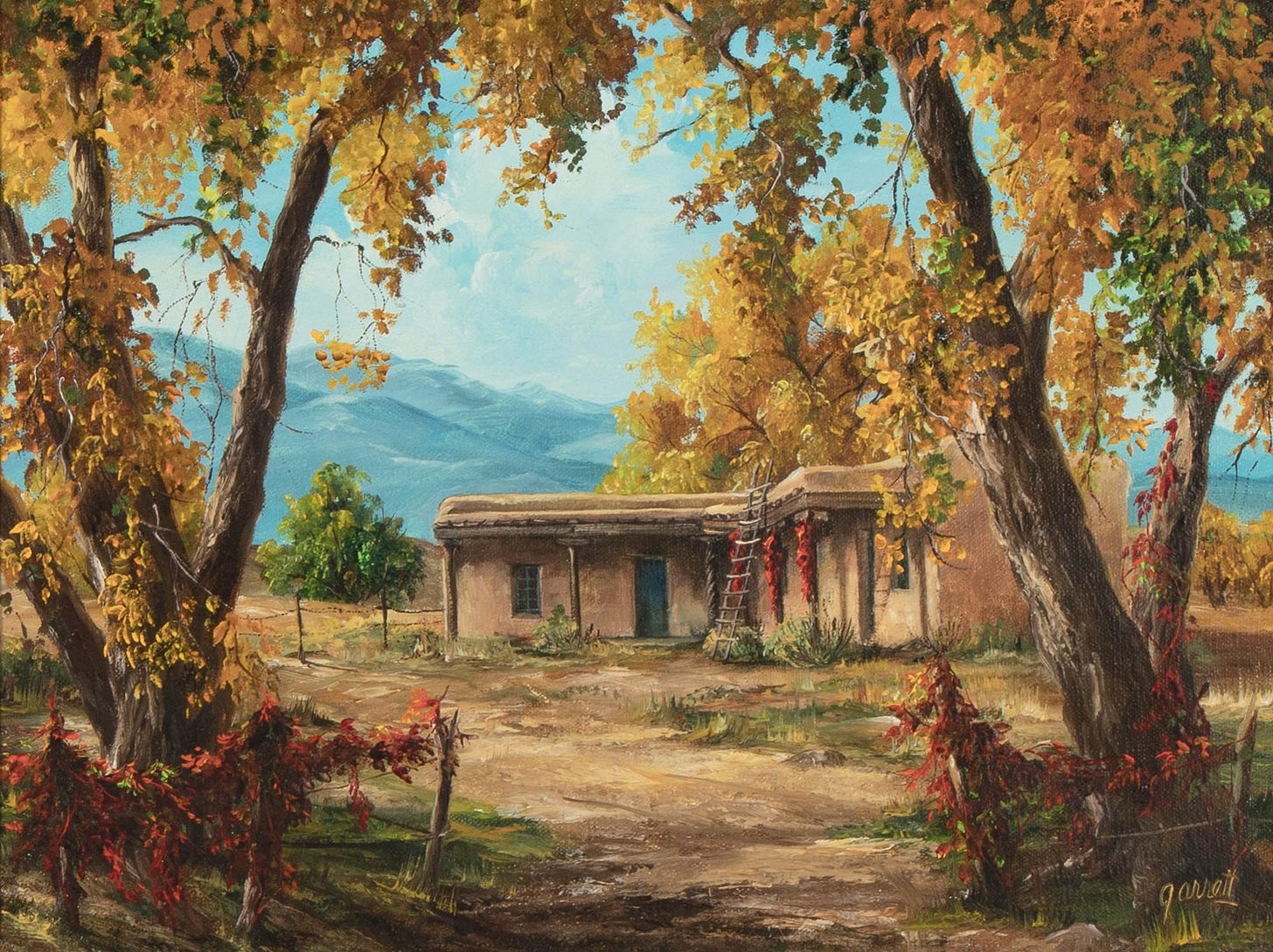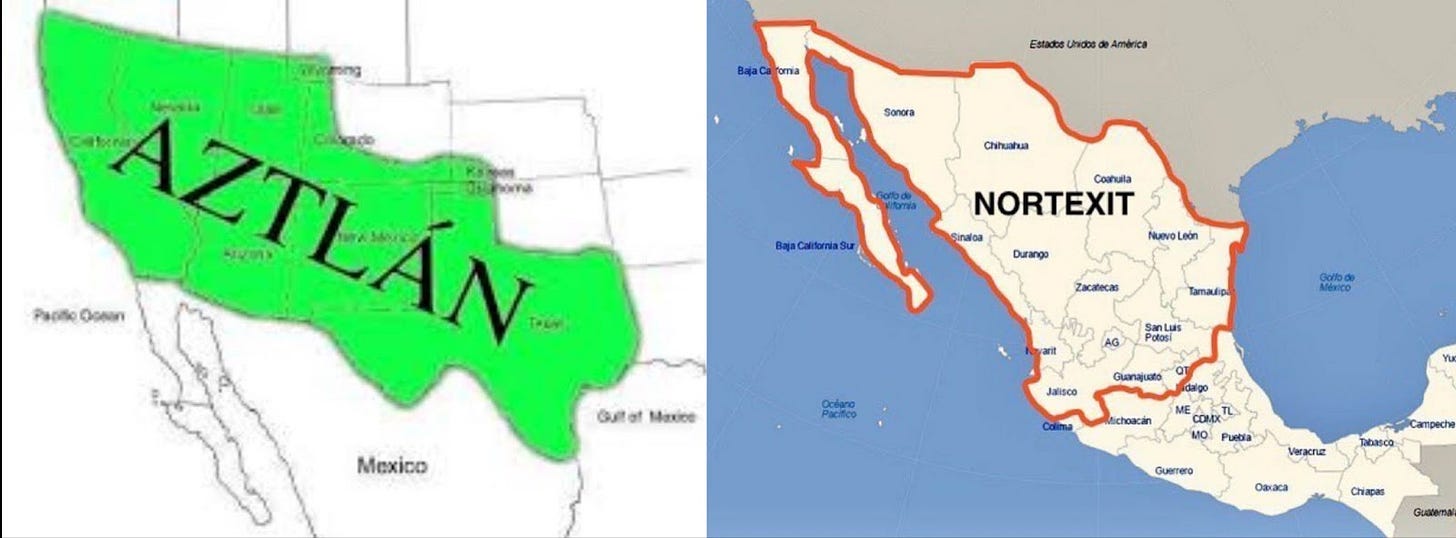To some, it is called the Southwest. Others refer to it as Northern Mexico or “El Norte.” Joel Garreau in his books describing The Nine Nations of North America refers to it as “Mex-America” To some it is a beacon of man’s arrogance living in a perceived hostile place. To some, it is a biodiverse sanctuary of the North American continent. Some view it as a tragedy to White Americans due to its large Hispanic population which grew over the 20th century, as well as a symbol of the decline of White Americans in general. Samuel P. Huntington in his work Clash of Civilizations referred to this land as a cleft, destined to fight amongst itself. On the contrary, others view it as diversity’s greatest triumph, due to the abnormally high social cohesion and cultural merger. To some, it is the most hostile border on earth. Some view it as a curiosity due to its thriving indigenous culture and unusual metaphysics as seen with the New Age movement; as well as its art which inspires people from all over the world to come to this place to artistically express themselves. Others see it as nature’s greatest gift with its near-endless expanse of geologic and natural wonders, an ethereal and eternal land.
This vast desert land is one which separates the Anglo and European worlds from the Latin American one. As well be discussed here and with this series of articles, I believe the land carries a greater secret and destiny, one which shapes its people immensely and will likely shape the future of Western Civilization (Or more specifically what may come after it). This article is meant to introduce the reader to the land, culture, and future. These will all be built upon within further pieces describing the history and unique properties of the land, as well as problems facing the area.
It is defined by mountainous land, deserts, highland alpine forests, and vast swathes of oppressively open space, and the land is nestled between the U.S. and Mexican borderlands, both the historic ones and the modern ones. The land can be best described as Aridoamerica, a term given to the area by Mexican anthropologists in the 1960s to describe the various Amerindian groups such as the Apache, Dine, O’odham, Comanche, Chumash, Havasupai, Yaqui, and sometimes the Various Puebloans as well as the other peoples that lived north of the Mesoamerican Civilization. This includes the Nahua which had people that both created and destroyed the Aztec empire. Those seven Nahua tribes originally came from these expansive deserts.
Aridoamerica is the term for this land not just to describe the many Amerindian communities here but carries with it two other meanings that make this the best term to describe the land. Aridoamerica carries with it two other meanings. It’s Spanish in its words, but also carries the term “America” which by many could be viewed as the United States (Pardon my Anglo usage of “America,” Spanish Speakers). The final reason to use this word to describe the land and its people is its ability to transcend the border. “Aztlan” was coined by the Chicano movement and is a great example of this. Despite being native and looking to the Nahua mythical homeland, it ends at contemporary borders. “El Norte” implies it’s the north of something and something else lies beyond. “Mex-America” also implies the binary. However, as will be made increasingly clear, this area is more internally unified culturally, socially, demographically, historically, geologically, and ecologically. The only things that separate this place is the result of two governments that lie vastly disconnected from the place.
Aridoamerica can be described as a geo-cultural region. The Aridoamerican Plane is a vast cultural zone that is defined by similar cultures, ethnic groups, and ecology. It extends from roughly Boise and the Snake River to the Volcanic Cordillera and is considerably more defined by vast deserts than the abundant American East Coast or Mesoamerica.
Demographically, there are three major groups here. The Whites, The Mestizos, and the Amerindians. Culturally there are also three major groups in the form of Anglo-Germanic Europeans, Hispanics, and Indigenous. There is considerable overlap in all of these groups so culture and demography will thus be counted as separate. There is a large minority of White-Hispanics and some non-white Anglos for example. The American side is much more Mestizo and Indigenous than the rest of its much more white country. The Mexican side meanwhile is more European than the rest of its country, and is ironically one of the most European areas in Latin America outside the Southern Cone, in relation to their more Mestizo/Amerindian host country. This is because these areas mirror each other, and not the sum of their national binary. Culturally both materially and mentally, is dominated by similar principles, and unified through land and a patchwork of similar ethnicities. Ranching, a connection to nature, distaste of hierarchy and more community-focused, obsession with self-sufficiency, and mythicizing their deserts. American concepts such as freedom, have evolved into entirely new cultural meanings as well. This is where cowboy and vaquero culture comes from. This similar culture has led to increasingly similar architecture. It’s defined by horizontality, Adobe Mud, Spanish Mission, false fronts, and increasingly, greenhouses and solar panels, giving buildings an almost organic tone.
View these lands as united and internal, rather than the sum of two binaries. The border is ancient style, imperial, and frontier. However modern politics have turned this false frontier border into a gigantic structure.
This has had considerable impacts on the world views, which can be described as rapidly evolving into its own consciousness, one abiding by a land so fundamentally alien to either the Temperate forests of Europe and Eastern America, as well as Mesoamerican and South American tropics that define most of Latin America. This has caused the formation of new world views entirely. The region right now is religiously diverse, but the dominant religions at the moment are Catholicism (Which is heavily indigenized), Mormonism, Various Protestant sects, New Age Spirituality which comes directly from the land, and holistic folk beliefs mainly practiced by the Indigenous. There also lies a Mystical undercurrent and many spiritual cults that inhabit this area as well. While all of these religions are diverse, they, like everything else involving its land, bleed into each other. Culture, architectural synthesis, world views, and ecological reality have pushed an entirely new cultural trajectory that is neither Western European or Latin American. These new land realities have given rise to many movements such as the Chicano movement, modern environmentalism, among others.
What do some of the highest Indigenous and Hispanic populations have to do with the highest Off-The-Grid living and New Age Spirituality adherence have to do with each other? They all share the same geography.
Parts will read like social justice coffee shop slam poetry, and some will appear fascistic. Some will look libertarian and others more conservative. Some will appear as hippy and other aspects will appear traditionalist. Some aspects will sound neoliberal, and some aspects will sound like Ted Kaczynski’s work. That’s because the Aridoamerican subconscious reality bubbles up in many different isms that define the modern political fights but hide a larger unseen reality, one that defines the life of the people. People are not a single political regime, they’re a people, one that has come and is coming. I believe there to be a new spiritual essence, a new perception of reality, new cultural forms, a new beginning. Under Spenglerian, Toynbian, and Quigleyan thinking, the area as will be argued here, appears to be on the trajectory of forming a new civilization entirely. One which integrates European and Indigenous thinking to form a new logical structure entirely as well as a rebirth of spirituality and metaphysics. This series will also feature unique civilizational elements of this land, its awakening, the unique people and cultures, a potentially very damaging Pseudomorphosis, as well as the history of the land and its people.
Whether you’re a Hispano living in the vast mountainous land of Southern Colorado, a Chicano in Laredo, an Apache overlooking the red vistas of San Carlos, Mormon in The Salt Lake Region, a German in Sonora and Chihuahua, a Mayan immigrant living in the vast concrete jungles of Los Angeles, or one of the other peoples of the Aridoamerican plane; this is a dedication of you, your history, your land, your culture, and what I believe to be your future. Given that, I’m not too fond of paywalls and use Wayback Machine to circumnavigate them, every single article will be free. Besides, sometimes time is worth more than its weight in gold, so every second spent reading these is heavily appreciated. Join me as I document The Dawn of Aridoamerica.
(Note: Substack is very new to me, so any critiques of my writing and the content is highly appreciated at this early stage.)









I'm so excited about this project. I'm starting to read the essays from the beginning. I'm a Mexican born in Chihuahua with family in Texas, New Mexico, Colorado and California. I currently live in Mexico City. Last year, I began working on my family tree and discovered that I have several ancestors that played their role in the early Spanish colonization of New Mexico. Some of them died or fled to Chihuahua during the Pueblo Revolt. I truly believe there is something special going on in the region, and I'm looking forward to reading your explorations on this topic. Best.
Thanks. Born in Montana, native ancestors, live in Maryland, traveled the US Southwest, family in Texas and Oklahoma, eager to read more.